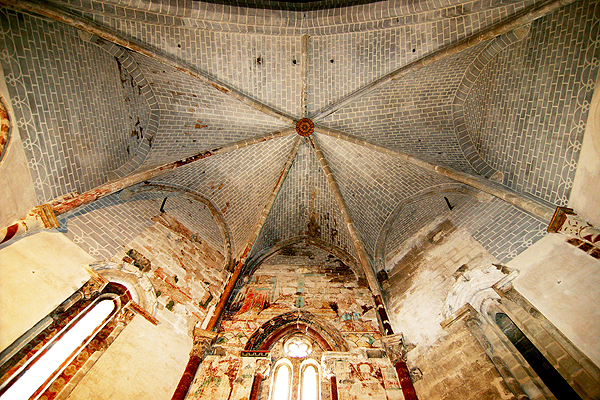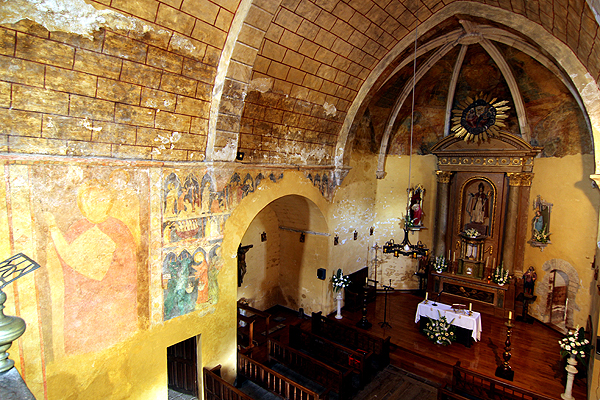17 October 2016
lecture series
THE SKIN OF ARCHITECTURE
Colour in Navarre's medieval architecture: a chronicle of loss and reunions
Carlos Martínez Álava
Mendillorri Secondary School
The withdrawal, 19th century-inspired restorations, fashions, ignorance, historicist recreations... managed to consolidate in our society an image of medieval architecture where stone monopolised the purity and truth of the building. Fortunately, this is not the case today. Obviously, the facings are decisive for the definition of the building. However, we have known for decades that medieval churches and castles were painted. Sometimes the exterior of doorways and façades were even polychromed. These spaces covered with colours and stories formed the skin of the architectural organism.
Within the cycle graduate"The skin of architecture" it was necessary to reflect on the role of mural painting in the medieval architecture of Navarre. To this end, we adopted a contemporary perspective, in which we became aware of its importance and value, based on the treatment that has been given to it since the 18th century. We set out to make a journey that would make up a chronicle of losses and encounters. Because this has been our relationship with the medieval pictorial coverings of the main buildings erected in Navarre between the 11th century and the early 16th century. Many have been irretrievably lost; others are preserved in museums or in a few churches. For the future we still have some interiors to explore, to rehabilitate, to rediscover.
As tourists or cultural visitors we experience architecture as a space, as an organism made up of elements and perspectives, most of the time with a profound plastic charge, for its order or disorder, for its grandeur or intimacy, for its closeness or remoteness, for its symmetry and illumination... These are purely artistic values.
But if we refer to the context that constructed them, we are not only missing colours, but a complete textual content that ended up defining the object or structure. In this sense, the loss of that message (which can range from the religious of the great pictorial ensembles, to the civil or chivalric of the paintings of the disappeared medieval royal palaces) is as substantial as the skin. It would be curious to observe the feeling of the faithful and patrons when they attended the Eucharist in the parish church of San Julián de Ororbia once the costly programmes of pictorial decoration of its interior had been completed. They would open their eyes wide to follow the cycle of the infancy of Jesus, his martyrdom and crucifixion, the resurrection of the dead, the Last Judgement. What would they have thought if, overnight, those coverings had disappeared and they found the presbytery of their parish church with the stone exposed, "naked"? This is another adjective that suits us particularly well. Indeed, they would feel the parish as if it were bare, as if it were skinned, as if it had no skin.
When the pictorial coverings disappear, what we lose in the case of medieval temples (and this is the major part of our bequest) is a good part of the message, of the literature that justified the being of the building itself. In this sense, we can speak of an architecture without skin, without text. Of an organism, if it is religious, and most of those we have preserved in Navarre are, mute in its foundational content, and in the history of its liturgical use. To understand it, we have to make the effort to see it through the eyes of the neighbours of yesteryear, of course. With eyes seven hundred years younger than ours. That would not be bad.
Clearly much has been lost. The chronicle of losses is very long. As Professor Marisa Melero pointed out, "the remains of mural painting have for us only the value of sampleor testimony of the paintings we have lost". It is sad to remember that this loss was not only due to neglect or withdrawal. For years there was active intervention in its destruction in order to rescue "the purity of the stone", the "seriousness of the building", the elegance of its forms....
It is more pleasing to reconstruct the chronicle of the reunions. In addition to the spectacular collections of Gothic mural painting that we have in the Museum of Navarre, since the last decades of the 20th century new testimonies have been added that give us an increasingly less fragmented idea of the reality of Gothic mural painting in Navarre. The only remains of Romanesque mural painting preserved in Navarre have even been found under the tower of the parish church of Rocaforte.
Let us see what we have preserved. In chronological order, the oldest mural paintings are those at Rocaforte, dating from the second third of the 12th century. In the 13th century we have the well-known paintings of Artaiz, Olite and Artajona, in the Museum of Navarre. These have recently been joined by those in the main chapels of Santa María de Olite and Santa María de Aibar. We do not know much about the oldest Gothic paintings.
Much more has come down to us from the workshops that worked in Navarre during the first half of the 14th century. The mural of the refectory of the cathedral of Pamplona, also in the Museum of Navarre, put on the western artistic map an important painter who formed a workshop in Pamplona. He is Juan Oliver. Fortunately, in recent years, his Catalog of works has grown considerably. We can relate to his authorship the decoration of the main chapel of San Julián de Ororbia, the cycle of Santa Ágata in Olloki and the apse of the Crucifix of Puente la Reina. And next to him stands out another painter, also based in Pamplona, named Roque, who signature the second paintings of Artajona (Museum of Navarre), and his way of doing is followed in the funerary arcosolium of Santa María de Ribas de Pamplona or the paintings of Azanza. And in the orbit of this School of Pamplona we can mention other interesting groups in Ujué, Ekai, Ardanaz, Eristáin, Aizpún, Gallipienzo ...

Church of San Saturnino de Artajona. Presbytery

Church of San Martín de Azanza
And the future will be kind to us. The chronicle of discoveries will continue. Such splendid, monumental and pure ensembles as the interior of San Salvador de Sangüesa await us. And a long list of works to be studied and rediscovered: Santa Brígida de Olite, Peña, San Zoilo de Cáseda, Belascoáin... Today we know how important it is to conserve these claddings. All that remains is to have the will and the means to study and recover them.

Olite. Santa Brígida
